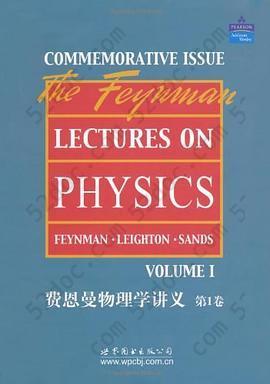注重体验与质量的电子书资源下载网站
分类于: 其它 编程语言
简介

费恩曼物理学讲义: 第一卷·英文版 豆 9.4分
资源最后更新于 2020-07-23 14:09:00
作者:Richard P. Feynman
出版社:世界图书出版北京公司
出版日期:2003-01
ISBN:9787506272476
文件格式: pdf
标签: 物理 费曼 物理学 Physics 英文原版 Feynman 科学 教材
简介· · · · · ·
Feynman et al,Thees are the lectures in physics that I gave last year and the year before to the freshman and sophomore classes at Caltech.The lectures are,of course,not verbatim-they have been edited,sometimes extensively and sometimes lessso.The lectures form only part of the complete courese.The whole group of 180students gathered in a big lecture room twice a week to hear t...
目录
chapter 1. atoms in motion .
1-1 introduction 1-1
1-2 matter is made of atoms 1-2
1-3 atomic processes 1-5
1-4 chemical reactions 1-6
chapter 2. basic physics
2-1 introduction 2-i
2-2 physics before 1920 2-3
2-3 quantum physics 2-6
2-4 nuclei and particles 2-8
chapter 3. the relation of physics to other sciences
3-1 introduction 3-1
3-2 chemistry 3-1
3-3 biology 3-2
3-4 astronomy 3-6
3-5 geology 3-7
3-6 psychology 3-8
3-7 how did it get that way ? 3-9
chapter 4. conservation of energy
4-1 what is energy? 4-1
.4-2 gravitational potential energy 4-2
4-3 kinetic energy 4-5
4-4 other forms of energy 4-6
chapter 5. time and distance
5-1 motion 5-1
5-2 time 5-1
5-3 short times 5-2
5-4 long times 5-3
5-5 units and standards of time 5-5
5-6 large distances 5-5
5-7 short distances 5-8
chaffer 6. probability
6-1 chance and likelihood 6-1
6-2 fluctuations 6-3
6-3 the random walk 6-5
6-4 a probability distribution 6-7
6-5 the uncertainty principle 6-10
chapter 7. the theory of gravitation
7-1 planetary motions 7-1
7-2 kepler's laws 7-1
7-3 development of dynamics 7-2
7-4 newton's law of gravitation 7-3
7-5 universal gravitation 7-5
7-6 cavendish's experiment 7-9
7-7 what is gravity ? 7-9
7-8 gravity and relativity 7-11
chapter 8. motion
8-1 description of motion 8-1
8-2 speed 8-2
8-3 speed as a derivative 8-5
8-4 distance as an integral 8-7
8-5 acceleration 8-8
chapter 9. newton's laws of dynamics
9-1 momentum and force 9-1
9-2 speed and velocity 9-2
9-3 components of velocity, acceleration, and force 9-3
9-4 what is the force? 9-3
9-5 meaning of the dynamical equations 9-4
9-6 numerical solution of the equations 9-5
9-7 planetary motions 9--6
chapter 10. conservation of momentum
10-1 newton's third law 10-1
10-2 conservation of momentum 10-2
10-3 momentum is conserved! 10-5
10-4 momentum and energy 10-7
10-5 relativistic momentum 10-8
chapter 11. vectors
11-1 symmetry in physics 11-1
11-2 translations 11-1
11-3 rotations 11-3
11-4 vectors 11-5
11-5 vector algebra 11-6
11-6 newton's laws in vector notation 11-7
11-7 scalar product of vectors 11-8
chapter 12. characteristics of force
12-1 what is a force7 i2-1
12-2 friction 12-3
12-3 molecular forces 12-6
12-4 fundamental forces. fields 12-7
12-5 pseudo forces 12-10
12-6 nuclear forces 12-12
chapter 13. work and potential energy (a)
13-1 energy of a falling body 13-1
13-2 work done by gravity 13-3
13-3 summation of energy 13-6
13-4 gravitational field of large objects 13-8
chapter 14. work and potential energy (conclusion)
14-1 work 14-1
14-2 constrained motion 14-3
14-3 conservative forces 14-3
14-4 nonconservative forces 14-6
14-5 potentials and fields 14-7
chapter 15. the special theory of relativity
15-1 the principle of relativity 15-1
15-2 the lorentz transformation 15-3
15-3 the michelson-morley experiment 15-3
15-4 transformation of time 15-5
15-5 the lorentz contraction 15-7
15-6 simultaneity 15-7
15-7 four-vectors 15-8
15-8 relativistic dynamics 15-9
15-9 equivalence of mass and energy 15-10
chapter 16. relativistic energy and momentum
16-1 relativity and the philosophers 16-1
16-2 the twin paradox 16-3
16-3 transformation of velocities 16-4
16-4 relativistic mass 16-6
16-5 relativistic energy 16-8
chapter 17. space=time
17-1 the geometry of space-time 17-1
17-2 space-time intervals 17-2
17-3 past, present, and future 17-4
17-4 more about four-vectors 17-5
17-5 four-vector algebra 17-7
chapter 18. rotation in two dimensions
18-1 the center of mass 18-1
18-2 rotation of a rigid body 18-2
18-3 angular momentum 18-5
18-4 conservation of angular momentum 18-6
chapter 19. center of mass; moment of inertia
19-1 properties of the center of mass 19-1
19-2 locating the center of mass 19-4
19-3 finding the moment of inertia 19-5
19-4 rotational kinetic energy 19-7
chapter 20. rotation in space
20-1 torques in three dimensions 20-1
20-2 the rotation equations using cross products 20-4
20-3 the gyroscope 20-5
20-4 angular momentum of a solid body 20-8
chapter 21. the harmonic oscillator
21-1 linear differential equations 21-1
21-2 the harmonic oscillator 21-1
21-3 harmonic motion and circular motion 21-4
21-4 initialconditions 21-4
21-5 forced oscillations 21-5
chapter 22. algeara
22-1 addition and multiplication 22-1
22-2 the inverse operations 22-2
22-3 abstraction and generalization 22-3
22-4 approximating irrational numbers 22-4
22-5 complex numbers 22-7
22-6 imaginary exponents 22-9
chapter 23. resonance
23-1 complex numbers and harmonic motion 23-1
23-2 the forced oscillator with damping 23-3
23-3 electrical resonance 23-5
23-4 resonance in nature 23-7
chapter 24. transients
24-1 the energy of an oscillator 24-1
24-2 damped oscillations 24-2
24-3 electrical transients 24-5
chapter 25. linear systems and review
25-1 linear differential equations 25-1
25-2 superposition of solutions 25-2
25-3 oscillations in linear systems 25-5
25-4 analogs in physics 25-6
25-5 series and parallel impedances 25-8
chapter 26. optics: the principle of least time ..
26-1 light 26-1
26-2 reflection and refraction 26-2
26-3 fermat's principle of least time 26-3
26-4 applications of fermat's principle 26-5
26-5 a more precise statement of fermat's principle 26-7
26-6 how it works 26-8
chapter 27. geometrical optics
27-1 introduction 27-1
27-2 the focal length of a spherical surface 27-1
27-3 the focal length of a lens 27-4
27-4 magnification 27-5
27-5 compound lenses 27-6
27-6 aberrations 27-7
27-7 resolving power 27-7
chapter 28. electromagnetic radiation
28-1 eiectromagnetism 28-1
28-2 radiation 28-3
28-3 the dipole radiator 28-5
28-4 interference 28-6
chapter 29. interference
29-1 electromagnetic waves 29-1
29-2 energy of radiation 29-2
29-3 sinusoidal waves 29-2
29-4 two dipole radiators 29-3
29-5 the mathematics of interference 29-5
chapter 30. diffraction
30-1 the resultant amplitude due to n equal oscillators 30-1
30-2 the diffraction grating 30-3
30-3 resolving power of a grating 30-5
30-4 the parabolic antenna 30-6
30-5 colored films; crystals 30-7
30-6 diffraction by opaque screens 30-8
30-7 the field of a plane of oscillating charges 30-10
chapter 31. the origin of the refractive index
31-1 the index of refraction 31-1
31-2 the field due to the material 31-4
31-3 dispersion 31-6
31-4 absorption 31-8
31-5 the energy carried by an electric wave 31-9
31-6 diffraction of light by a screen 31-10
chapter 32. radiation damping. light scattering
32-1 radiation resistance 32-1
32-2 the rate of radiation of energy 32-2
32-3 radiation damping 32-3
32-4 independent sources 32-5
32-5 scaftering of light 32-6
chapter 33. polarization
33-1 the electric vector of light 33-1
33-2 polarization of scattered light 33-3
33-3 birefringence 33-3
33-4 polarizers 33-5
33-5 optical activity 33-6
33-6 the intensity of reflected light 33-7
33-7 anomalous refraction 33-9
chapter 34. relativistic effects in radiation
34-1 moving sources 34-1
34-2 finding the "apparent" motion 34-2
34-3 synchrotron radiation 34-3
34-4 cosmic synchrotron radiation 34-6
34-5 bremsstrahlung 34-6
34-6 the doppler effect 34-7
34-7 the co, k four-vector 34-9
34-8 aberration 34-10
34-9 the momentum of light 34-10
chapter 35, color vision
35-1 the human eye 35-1
35-2 color depends on intensity 35-2
35-3 measuring the color sensation 35-3
35-4 the chromaticity diagram 35-6
35-5 the mechanism of color vision 35-7
35-6 physiochemistry of color vision 35-9
chapter 36. mechanisms of seeing
36-1 the sensation of color 36-1
36-2 the physiology of the eye 36-3
36-3 the rod cells 36-6
36--4 the compound (insect) eye. 36-6
36-5 other eyes 36-9
36.-6 neurology of vision 36-9
chapter 37. quantum behavior
37-1 atomic mechanics 37-1
37-2 an experiment with bullets 37-2
37-3 an experiment with waves 37-3
37-4 an experiment with electrons 37-4
37-5 the interference of electron waves 37-5
37-6 watching the electrons 37-7
37-7 first principles of quantum mechanics 37-10
37-8 the uncertainty principle 37-11
chapter 38. the relation of wave and particle
viewpoints
38-1 probability wave amplitudes 38-1
38-2 measurement of position and momentum 38-2
38-3 crystal diffraction 38-4
38-4 the size of an atom 38-5
38-5 energy levels 38-7
38-6 philosophical implications 38-8
chapter 39. the kinetic theory of gases
39-1 properties of matter 39-1
39-2 the pressure of a gas 39-2
39-3 compressibility of radiation 39-6
39-4 temperature and kinetic energy 39-6
39-5 the ideal gas law 39-10
chapter 40. the principles of statistical mechanics
40-1 the exponential atmosphere 40-i
40-2 the boltzmann law 40-2
40-3 evaporation of a liquid 40-3
40-4 the distribution of molecular speeds 40-4
40-5 the specific heats of gases 40-7
40-6 the failure of classical physics 40-8
chapter 41. the brownian movement
41-1 equipartition of energy 41-1
41-2 thermal equilibrium of radiation 41-3
41-3 equipartition and the quantum oscillator 41-6
41-4 the random walk 41-8
chapter 42. applications of kinetic theory
42-1 evaporation 42-1
42-2 thermionic emission 42-4
42-3 thermal ionization 42-5
42-4 chemical kinetics 42-7
42-5 einstein's laws of radiation 42-8
chapter 43. diffusion
43-1 collisions between molecules 43-1
43-2 the mean free path 43-3
43-3 the drift speed 43-4
43-4 ionic conductivity 43-6
43-5 molecular diffusion 43-7
43-6 thermal conductivity 43-9
chapter 44. the laws of thermodynamics
44-1 heat engines; the first law 44-1
44-2 the second law 44-3
44-3 reversible engines 44-4
44-4 the efficiency of an ideal engine 44-7
44-5 the thermodynamic temperature 44-9
44-6 entropy 44-10
chapter 45. illustrations of thermodynamics
45-1 internal energy 45-1
45-2 applications 45-4
45-3 the clausius-clapeyron equation 45-6
chapter 46. ratchet and pawl
46-1 how a ratchet works 46-1
46-2 the ratchet as an engine 46-2
46-3 reversibility in mechanics 46-4
46-4 irreversibility 46-5
46-5 order and entropy 46-7
chapter 47. sound. the wave equation
47-1 waves 47-1
47-2 the propagation of sound 47-3
47-3 the wave equation 47-4
47-4 solutions of the wave equation 47-6
47-5 the speed of sound 47-7
chapter 48. beats
48-1 adding two waves 48-1
48-2 beat notes and modulation 48-3
48-3 side bands 48-4
48-4 localized wave trains 48-5
48-5 probability amplitudes for particles 48-7
48-6 waves in three dimensions 48-9
48-7 normal modes 48-10
chapter 49. modes
49-1 the reflection of waves 49-1
49-2 confined waves, with natural frequencies 49-2
49-3 modes in two dimensions 49-3
49-4 coupled pendulums 49-6
49-5 linear systems 49-7
index
chapter 50. harmonics
50-1 musical tones 50-1
50-2 the fourier series 50-2
50-3 quality and consonance 50-3
50-4 the fourier coefficients 50-5
50-5 the energy theorem 50-7
50-6 nonlinear responses 50-8
chapter 51. waves
51-1 bow waves 51-1
51-2 shock waves 51-2
51-3 waves in solids 51-4
51-4 surface waves 51-7
chapter 52. symmetry in physical laws
52-1 symmetry operations 52-1
52-2 symmetry in space and time 52-1
52-3 symmetry and conservation laws 52-3
52-4 mirror reflections 52-4
52-5 polar and axial vectors 52-6
52-6 which hand is right? 52-8
52-7 parity is not conserved! 52-8
52-8 antimatter 52-10
52-9 broken symmetries 52-11
1-1 introduction 1-1
1-2 matter is made of atoms 1-2
1-3 atomic processes 1-5
1-4 chemical reactions 1-6
chapter 2. basic physics
2-1 introduction 2-i
2-2 physics before 1920 2-3
2-3 quantum physics 2-6
2-4 nuclei and particles 2-8
chapter 3. the relation of physics to other sciences
3-1 introduction 3-1
3-2 chemistry 3-1
3-3 biology 3-2
3-4 astronomy 3-6
3-5 geology 3-7
3-6 psychology 3-8
3-7 how did it get that way ? 3-9
chapter 4. conservation of energy
4-1 what is energy? 4-1
.4-2 gravitational potential energy 4-2
4-3 kinetic energy 4-5
4-4 other forms of energy 4-6
chapter 5. time and distance
5-1 motion 5-1
5-2 time 5-1
5-3 short times 5-2
5-4 long times 5-3
5-5 units and standards of time 5-5
5-6 large distances 5-5
5-7 short distances 5-8
chaffer 6. probability
6-1 chance and likelihood 6-1
6-2 fluctuations 6-3
6-3 the random walk 6-5
6-4 a probability distribution 6-7
6-5 the uncertainty principle 6-10
chapter 7. the theory of gravitation
7-1 planetary motions 7-1
7-2 kepler's laws 7-1
7-3 development of dynamics 7-2
7-4 newton's law of gravitation 7-3
7-5 universal gravitation 7-5
7-6 cavendish's experiment 7-9
7-7 what is gravity ? 7-9
7-8 gravity and relativity 7-11
chapter 8. motion
8-1 description of motion 8-1
8-2 speed 8-2
8-3 speed as a derivative 8-5
8-4 distance as an integral 8-7
8-5 acceleration 8-8
chapter 9. newton's laws of dynamics
9-1 momentum and force 9-1
9-2 speed and velocity 9-2
9-3 components of velocity, acceleration, and force 9-3
9-4 what is the force? 9-3
9-5 meaning of the dynamical equations 9-4
9-6 numerical solution of the equations 9-5
9-7 planetary motions 9--6
chapter 10. conservation of momentum
10-1 newton's third law 10-1
10-2 conservation of momentum 10-2
10-3 momentum is conserved! 10-5
10-4 momentum and energy 10-7
10-5 relativistic momentum 10-8
chapter 11. vectors
11-1 symmetry in physics 11-1
11-2 translations 11-1
11-3 rotations 11-3
11-4 vectors 11-5
11-5 vector algebra 11-6
11-6 newton's laws in vector notation 11-7
11-7 scalar product of vectors 11-8
chapter 12. characteristics of force
12-1 what is a force7 i2-1
12-2 friction 12-3
12-3 molecular forces 12-6
12-4 fundamental forces. fields 12-7
12-5 pseudo forces 12-10
12-6 nuclear forces 12-12
chapter 13. work and potential energy (a)
13-1 energy of a falling body 13-1
13-2 work done by gravity 13-3
13-3 summation of energy 13-6
13-4 gravitational field of large objects 13-8
chapter 14. work and potential energy (conclusion)
14-1 work 14-1
14-2 constrained motion 14-3
14-3 conservative forces 14-3
14-4 nonconservative forces 14-6
14-5 potentials and fields 14-7
chapter 15. the special theory of relativity
15-1 the principle of relativity 15-1
15-2 the lorentz transformation 15-3
15-3 the michelson-morley experiment 15-3
15-4 transformation of time 15-5
15-5 the lorentz contraction 15-7
15-6 simultaneity 15-7
15-7 four-vectors 15-8
15-8 relativistic dynamics 15-9
15-9 equivalence of mass and energy 15-10
chapter 16. relativistic energy and momentum
16-1 relativity and the philosophers 16-1
16-2 the twin paradox 16-3
16-3 transformation of velocities 16-4
16-4 relativistic mass 16-6
16-5 relativistic energy 16-8
chapter 17. space=time
17-1 the geometry of space-time 17-1
17-2 space-time intervals 17-2
17-3 past, present, and future 17-4
17-4 more about four-vectors 17-5
17-5 four-vector algebra 17-7
chapter 18. rotation in two dimensions
18-1 the center of mass 18-1
18-2 rotation of a rigid body 18-2
18-3 angular momentum 18-5
18-4 conservation of angular momentum 18-6
chapter 19. center of mass; moment of inertia
19-1 properties of the center of mass 19-1
19-2 locating the center of mass 19-4
19-3 finding the moment of inertia 19-5
19-4 rotational kinetic energy 19-7
chapter 20. rotation in space
20-1 torques in three dimensions 20-1
20-2 the rotation equations using cross products 20-4
20-3 the gyroscope 20-5
20-4 angular momentum of a solid body 20-8
chapter 21. the harmonic oscillator
21-1 linear differential equations 21-1
21-2 the harmonic oscillator 21-1
21-3 harmonic motion and circular motion 21-4
21-4 initialconditions 21-4
21-5 forced oscillations 21-5
chapter 22. algeara
22-1 addition and multiplication 22-1
22-2 the inverse operations 22-2
22-3 abstraction and generalization 22-3
22-4 approximating irrational numbers 22-4
22-5 complex numbers 22-7
22-6 imaginary exponents 22-9
chapter 23. resonance
23-1 complex numbers and harmonic motion 23-1
23-2 the forced oscillator with damping 23-3
23-3 electrical resonance 23-5
23-4 resonance in nature 23-7
chapter 24. transients
24-1 the energy of an oscillator 24-1
24-2 damped oscillations 24-2
24-3 electrical transients 24-5
chapter 25. linear systems and review
25-1 linear differential equations 25-1
25-2 superposition of solutions 25-2
25-3 oscillations in linear systems 25-5
25-4 analogs in physics 25-6
25-5 series and parallel impedances 25-8
chapter 26. optics: the principle of least time ..
26-1 light 26-1
26-2 reflection and refraction 26-2
26-3 fermat's principle of least time 26-3
26-4 applications of fermat's principle 26-5
26-5 a more precise statement of fermat's principle 26-7
26-6 how it works 26-8
chapter 27. geometrical optics
27-1 introduction 27-1
27-2 the focal length of a spherical surface 27-1
27-3 the focal length of a lens 27-4
27-4 magnification 27-5
27-5 compound lenses 27-6
27-6 aberrations 27-7
27-7 resolving power 27-7
chapter 28. electromagnetic radiation
28-1 eiectromagnetism 28-1
28-2 radiation 28-3
28-3 the dipole radiator 28-5
28-4 interference 28-6
chapter 29. interference
29-1 electromagnetic waves 29-1
29-2 energy of radiation 29-2
29-3 sinusoidal waves 29-2
29-4 two dipole radiators 29-3
29-5 the mathematics of interference 29-5
chapter 30. diffraction
30-1 the resultant amplitude due to n equal oscillators 30-1
30-2 the diffraction grating 30-3
30-3 resolving power of a grating 30-5
30-4 the parabolic antenna 30-6
30-5 colored films; crystals 30-7
30-6 diffraction by opaque screens 30-8
30-7 the field of a plane of oscillating charges 30-10
chapter 31. the origin of the refractive index
31-1 the index of refraction 31-1
31-2 the field due to the material 31-4
31-3 dispersion 31-6
31-4 absorption 31-8
31-5 the energy carried by an electric wave 31-9
31-6 diffraction of light by a screen 31-10
chapter 32. radiation damping. light scattering
32-1 radiation resistance 32-1
32-2 the rate of radiation of energy 32-2
32-3 radiation damping 32-3
32-4 independent sources 32-5
32-5 scaftering of light 32-6
chapter 33. polarization
33-1 the electric vector of light 33-1
33-2 polarization of scattered light 33-3
33-3 birefringence 33-3
33-4 polarizers 33-5
33-5 optical activity 33-6
33-6 the intensity of reflected light 33-7
33-7 anomalous refraction 33-9
chapter 34. relativistic effects in radiation
34-1 moving sources 34-1
34-2 finding the "apparent" motion 34-2
34-3 synchrotron radiation 34-3
34-4 cosmic synchrotron radiation 34-6
34-5 bremsstrahlung 34-6
34-6 the doppler effect 34-7
34-7 the co, k four-vector 34-9
34-8 aberration 34-10
34-9 the momentum of light 34-10
chapter 35, color vision
35-1 the human eye 35-1
35-2 color depends on intensity 35-2
35-3 measuring the color sensation 35-3
35-4 the chromaticity diagram 35-6
35-5 the mechanism of color vision 35-7
35-6 physiochemistry of color vision 35-9
chapter 36. mechanisms of seeing
36-1 the sensation of color 36-1
36-2 the physiology of the eye 36-3
36-3 the rod cells 36-6
36--4 the compound (insect) eye. 36-6
36-5 other eyes 36-9
36.-6 neurology of vision 36-9
chapter 37. quantum behavior
37-1 atomic mechanics 37-1
37-2 an experiment with bullets 37-2
37-3 an experiment with waves 37-3
37-4 an experiment with electrons 37-4
37-5 the interference of electron waves 37-5
37-6 watching the electrons 37-7
37-7 first principles of quantum mechanics 37-10
37-8 the uncertainty principle 37-11
chapter 38. the relation of wave and particle
viewpoints
38-1 probability wave amplitudes 38-1
38-2 measurement of position and momentum 38-2
38-3 crystal diffraction 38-4
38-4 the size of an atom 38-5
38-5 energy levels 38-7
38-6 philosophical implications 38-8
chapter 39. the kinetic theory of gases
39-1 properties of matter 39-1
39-2 the pressure of a gas 39-2
39-3 compressibility of radiation 39-6
39-4 temperature and kinetic energy 39-6
39-5 the ideal gas law 39-10
chapter 40. the principles of statistical mechanics
40-1 the exponential atmosphere 40-i
40-2 the boltzmann law 40-2
40-3 evaporation of a liquid 40-3
40-4 the distribution of molecular speeds 40-4
40-5 the specific heats of gases 40-7
40-6 the failure of classical physics 40-8
chapter 41. the brownian movement
41-1 equipartition of energy 41-1
41-2 thermal equilibrium of radiation 41-3
41-3 equipartition and the quantum oscillator 41-6
41-4 the random walk 41-8
chapter 42. applications of kinetic theory
42-1 evaporation 42-1
42-2 thermionic emission 42-4
42-3 thermal ionization 42-5
42-4 chemical kinetics 42-7
42-5 einstein's laws of radiation 42-8
chapter 43. diffusion
43-1 collisions between molecules 43-1
43-2 the mean free path 43-3
43-3 the drift speed 43-4
43-4 ionic conductivity 43-6
43-5 molecular diffusion 43-7
43-6 thermal conductivity 43-9
chapter 44. the laws of thermodynamics
44-1 heat engines; the first law 44-1
44-2 the second law 44-3
44-3 reversible engines 44-4
44-4 the efficiency of an ideal engine 44-7
44-5 the thermodynamic temperature 44-9
44-6 entropy 44-10
chapter 45. illustrations of thermodynamics
45-1 internal energy 45-1
45-2 applications 45-4
45-3 the clausius-clapeyron equation 45-6
chapter 46. ratchet and pawl
46-1 how a ratchet works 46-1
46-2 the ratchet as an engine 46-2
46-3 reversibility in mechanics 46-4
46-4 irreversibility 46-5
46-5 order and entropy 46-7
chapter 47. sound. the wave equation
47-1 waves 47-1
47-2 the propagation of sound 47-3
47-3 the wave equation 47-4
47-4 solutions of the wave equation 47-6
47-5 the speed of sound 47-7
chapter 48. beats
48-1 adding two waves 48-1
48-2 beat notes and modulation 48-3
48-3 side bands 48-4
48-4 localized wave trains 48-5
48-5 probability amplitudes for particles 48-7
48-6 waves in three dimensions 48-9
48-7 normal modes 48-10
chapter 49. modes
49-1 the reflection of waves 49-1
49-2 confined waves, with natural frequencies 49-2
49-3 modes in two dimensions 49-3
49-4 coupled pendulums 49-6
49-5 linear systems 49-7
index
chapter 50. harmonics
50-1 musical tones 50-1
50-2 the fourier series 50-2
50-3 quality and consonance 50-3
50-4 the fourier coefficients 50-5
50-5 the energy theorem 50-7
50-6 nonlinear responses 50-8
chapter 51. waves
51-1 bow waves 51-1
51-2 shock waves 51-2
51-3 waves in solids 51-4
51-4 surface waves 51-7
chapter 52. symmetry in physical laws
52-1 symmetry operations 52-1
52-2 symmetry in space and time 52-1
52-3 symmetry and conservation laws 52-3
52-4 mirror reflections 52-4
52-5 polar and axial vectors 52-6
52-6 which hand is right? 52-8
52-7 parity is not conserved! 52-8
52-8 antimatter 52-10
52-9 broken symmetries 52-11








